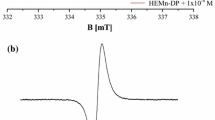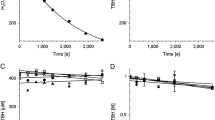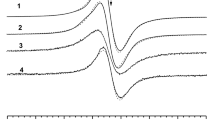Abstract
Electron paramagnetic resonance (EPR) spectroscopy was used to examine free radical properties of model neuromelanins obtained by oxidative polymerization of noradrenaline, adrenaline and dopamine. We compared the lineshape of the experimental spectra, type and concentration of free radicals in the analyzed samples. The effect of different concentrations of Cu2+ on free radicals in melanins was studied. The total concentration of free radicals (about 1018 to 1019 spin/g) in the studied melanins increases as follows: adrenaline-melanin < dopamine-melanin < noradrenaline-melanin. EPR spectra of dopamine-melanin and adrenaline-melanin were a single EPR line (ΔB pp, 0.50 and 0.55 mT, respectively). o-Semiquinone free radicals with the characteristicg-value of 2.0040 exist in these melanins. EPR spectra of noradrenaline-melanin were a superposition of two lines (ΔB pp, 0.45 and 0.81 mT). o-Semiquinone free radicals were responsible for the narrower component. Nitrogen free radicals with ag-factor of 2.0030 were probably responsible for the broader component. Paramagnetic copper ions quenched the EPR signals of melanin free radicals in the studied samples. For melanin-Cu2+ complexes, broad EPR lines (ΔB pp, 10–32 mT) of copper ions with ag-value of about 2.1 appeared. The influence of the microwave power on the EPR spectra of these complexes demonstrated the fast spin-lattice relaxation in the copper system in melanins.
Similar content being viewed by others
References
Chio S.-S., Hyde J.S., Sealy R.C.: Arch. Biochem. Biophys.199, 133–139 (1980)
Chio S.-S., Hyde J.S., Sealy R.C.: Arch. Biochem. Biophys.215, 100–106 (1982)
Sarna T., Sealy R.C.: Arch. Biochem. Biophys.232, 574–578 (1984)
Pasenkiewicz-Gierula M., Sealy R.C.: Biochim. Biophys. Acta884, 510–516 (1986)
Pascutti P.G., Ito A.S.: J. Photochem. Photobiol. B16, 257–266 (1992)
Sarna T., Hyde J.S., Swartz H.M.: Science192, 1132–134 (1977)
Buszman E., Kopera M., Wilczok T.: Biochem. Pharmacol.33, 7–11 (1984)
Buszman E., Pilawa B., Latocha M., Wilczok T., Tyrawska-Spychałowa D., Bajan C., Bijak A., Bilińska B.: Curr. Top. Biophys.22, 22–24 (1998)
Pilawa B., Stępień K., Wilczok T.: Curr. Top. Biophys.18, 132–134 (1994)
Stępień K.B., Dworzański J.P., Imielski S., Wilczok T.: J. Chem. Soc. C1986, 297–307.
Wertz J.E., Bolton J.R.: Electron Spin Resonance. Elementary Theory and Practical Applications. New York: Academic Press 1986.
Jastrzębska M.M., Isotalo H., Paloheimo J., Stubb H., Pilawa B.: J. Biomater. Sci. Polymer Edn.7, 781–793 (1996)
Author information
Authors and Affiliations
Corresponding author
Rights and permissions
About this article
Cite this article
Pilawa, B., Chodurek, E. & Wilczok, T. Types of paramagnetic centers in Cu2+ complexes with model neuromelanins. Appl. Magn. Reson. 24, 417–422 (2003). https://doi.org/10.1007/BF03166944
Received:
Revised:
Issue Date:
DOI: https://doi.org/10.1007/BF03166944




